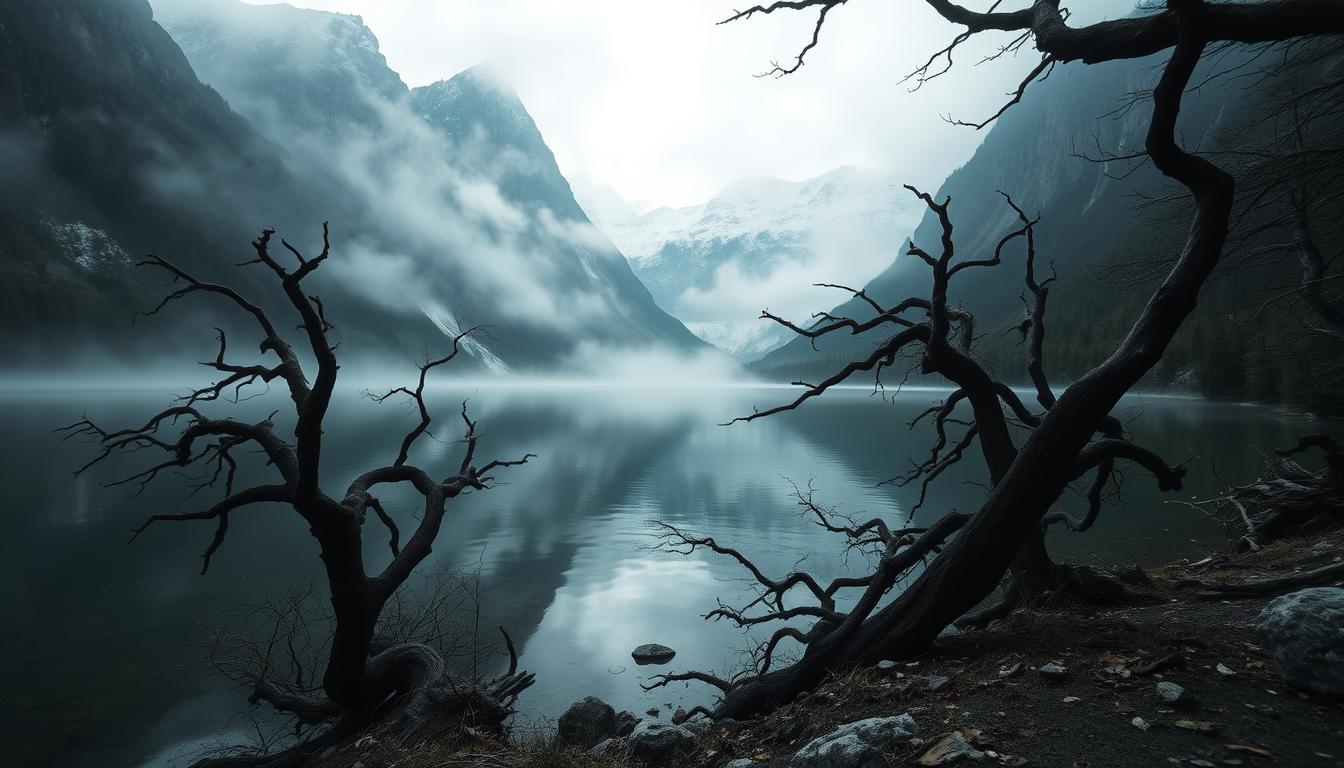Did you know that some of the world’s most stunning lakes hold secrets that even scientists struggle to explain? These natural wonders, often surrounded by breathtaking landscapes, challenge our understanding of how water behaves. From vibrant colors to unexplained phenomena, these bodies of water are more than just scenic spots—they’re puzzles waiting to be solved.
While most lakes form through predictable processes, a few defy logic. Some have unusual properties, like changing colors or supporting unique forms of life. Others are linked to local legends and historical events that add to their intrigue. This article dives into these fascinating mysteries, blending science and storytelling to uncover what makes these water bodies so extraordinary.
Key Takeaways
- Some lakes exhibit behaviors that challenge scientific understanding.
- Their unique features often make them visually stunning.
- Local legends and history add to their mysterious appeal.
- These water bodies are more than just natural wonders—they’re scientific enigmas.
- Exploring these lakes offers a blend of beauty and curiosity.
- Introduction: Unveiling the World’s Mysterious Lakes
- Gafsa Lake, Tunisia: A Lake That Appeared Out of Nowhere
- Roopkund Lake, India: The Chilling Tale of Frozen Remains
- Lake Nyos, Cameroon: The Deadly CO2 Catastrophe
- Lake Peigneur, Louisiana: When Drilling Unleashed a Sinkhole
- Baotou Toxic Lake, Inner Mongolia: Pollution’s Surreal Landscape
- Lake Natron, Tanzania: Nature’s Stone-Casting Waters
- Kawah Ijen Crater Lake, Indonesia: Fiery Beauty with a Lethal Edge
- 10 Strange Lakes That Defy Scientific Explanation: Pitch Lake, Lost Lake, and Yellowstone Lake
- Conclusion
- FAQ
- What makes a lake appear mysterious or strange?
- How did Gafsa Lake in Tunisia form so suddenly?
- What is the story behind Roopkund Lake’s frozen remains?
- What caused the deadly event at Lake Nyos in Cameroon?
- How did Lake Peigneur in Louisiana transform into a sinkhole?
- Why is Baotou Lake in Inner Mongolia considered toxic?
- What makes Lake Natron in Tanzania turn animals into stone?
- What are the dangers of Kawah Ijen Crater Lake in Indonesia?
- What is unique about Pitch Lake in Trinidad?
- Why does Lost Lake in Oregon disappear annually?
- What makes Yellowstone Lake in the USA a potential threat?
Introduction: Unveiling the World’s Mysterious Lakes
Not all lakes are created equal—some possess features that baffle even experts. These bodies of water often defy expectations, blending beauty with mystery. From their unique surface properties to the legends surrounding them, they captivate both scientists and storytellers alike.
What Makes a Lake Strange?
Most lakes are calm and predictable, but others stand out for their unusual traits. A “strange” lake might have a vibrant color, unexplained movements, or even a connection to local myths. These features make them more than just bodies of water—they’re natural puzzles.
For example, some lakes change color with the sky, while others seem to vanish overnight. These anomalies challenge our understanding of nature and spark curiosity. Below is a comparison of typical and unusual lake characteristics:
| Typical Lakes | Unusual Lakes |
|---|---|
| Calm, uniform appearance | Vivid colors or patterns |
| Predictable water levels | Fluctuating or disappearing waters |
| Common wildlife | Unique or rare species |
The Intersection of Science and Local Lore
Science often explains natural phenomena, but some lakes remain shrouded in mystery. Local storys and legends add another layer of intrigue. These tales, passed down through generations, offer explanations that science cannot always provide.
For instance, a lake might be linked to a historical event or a mythical creature. These narratives enrich our understanding and make these places even more fascinating. The blend of fact and fiction creates a unique world where nature and culture intertwine.
As we explore these lakes, we’ll uncover the science behind their mysteries and the stories that make them unforgettable. Prepare to dive into a journey that blends curiosity, discovery, and wonder.
Gafsa Lake, Tunisia: A Lake That Appeared Out of Nowhere
In 2014, a massive azure lake appeared in Tunisia’s arid landscape, leaving locals and scientists in awe. This body of water, now known as Gafsa Lake, emerged seemingly overnight in a region that had been dry for decades. Its sudden appearance sparked curiosity and debate about its origins.
Sudden Emergence and Brilliant Azure Waters
Theories suggest that a rupture above the water table brought underground water to the surface. This geological event created a lake with a stunning bright azure color, making it an instant attraction. The depth of the lake, estimated at several meters, added to its allure.
Despite its beauty, the water’s source raised concerns. Unregulated mining in the area may have weakened the rock layers, leading to the rupture. This human activity likely played a role in the lake’s sudden formation.
Local Reactions and Unregulated Mining Influence
Locals quickly embraced the lake, using it for swimming and recreation. However, scientists warned that the water might be toxic due to its unknown mineral content. The lake’s vibrant color, while inviting, could mask potential dangers.
The area’s mining history adds another layer to the story. Decades of unregulated phosphate mining altered the local geology, possibly contributing to the lake’s emergence. This blend of natural and human factors makes Gafsa Lake a true wonder of the modern world.
Today, Gafsa Lake stands as a reminder of nature’s unpredictability and the impact of human activity. Its story continues to captivate those who visit, offering a mix of beauty, mystery, and caution.
Roopkund Lake, India: The Chilling Tale of Frozen Remains
Nestled high in the Himalayas, Roopkund Lake hides a chilling secret beneath its icy surface. Known as the “Skeleton Lake,” this remote body of water is famous for the hundreds of human remains scattered along its shore. Discovered by British troops in 1942, the skeletons date back to around 850 AD, sparking decades of speculation and investigation.
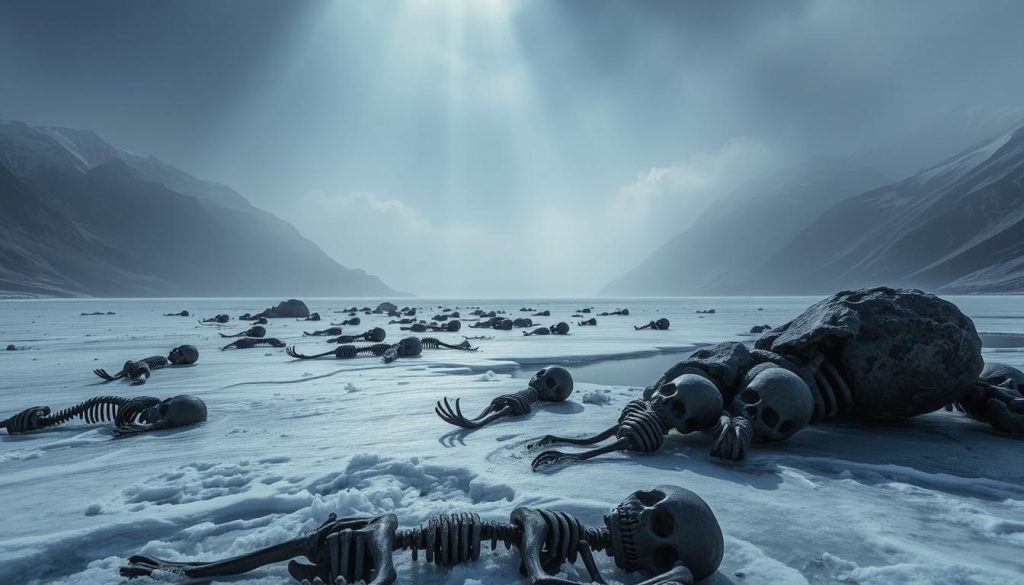
Discovery of Decaying Skeletons and Unexplained Deaths
When the British first stumbled upon the lake, they were met with a haunting sight: a patch of decaying skeletons partially submerged in the icy waters. Initial theories suggested a massacre or a lost army, but further archaeological study revealed a different story. The remains belonged to a group of pilgrims, likely traveling through the treacherous mountain pass.
Scientists found evidence of fatal head injuries, but the cause remained unclear. It wasn’t until later that a startling theory emerged: a catastrophic hailstorm. Researchers believe that enormous hailstones, some the size of cricket balls, struck the group, leading to their sudden and tragic deaths.
The Legend of the Giant Hailstorm
Local folklore adds another layer to this mysterious tale. According to legend, a mountain goddess, angered by the pilgrims’ disrespect, unleashed a giant hailstorm to punish them. This story, passed down through generations, aligns eerily with the scientific findings. The blend of myth and reality makes Roopkund Lake a fascinating subject for both historians and scientists.
“The lake’s skeletal remains are a reminder of nature’s unpredictable power and the fragility of human life.”
Today, Roopkund Lake continues to captivate visitors with its eerie beauty and chilling history. The stark, frozen landscape, combined with the skeletal remains, creates an atmosphere of both fear and fascination. Whether drawn by curiosity or a love of mystery, those who visit this remote lake are left with a profound sense of wonder.
| Scientific Explanation | Local Legend |
|---|---|
| Catastrophic hailstorm caused fatal injuries. | Mountain goddess unleashed a giant hailstorm. |
| Remains date back to 850 AD. | Pilgrims were punished for disrespect. |
| Evidence of sudden, tragic deaths. | Story passed down through generations. |
Lake Nyos, Cameroon: The Deadly CO2 Catastrophe
In 1986, a quiet lake in Cameroon became the site of one of the deadliest natural disasters in history. Lake Nyos, a volcanic crater lake, appeared serene but hid a deadly secret beneath its surface. This mystery would shock the world and leave a lasting impact on the region.
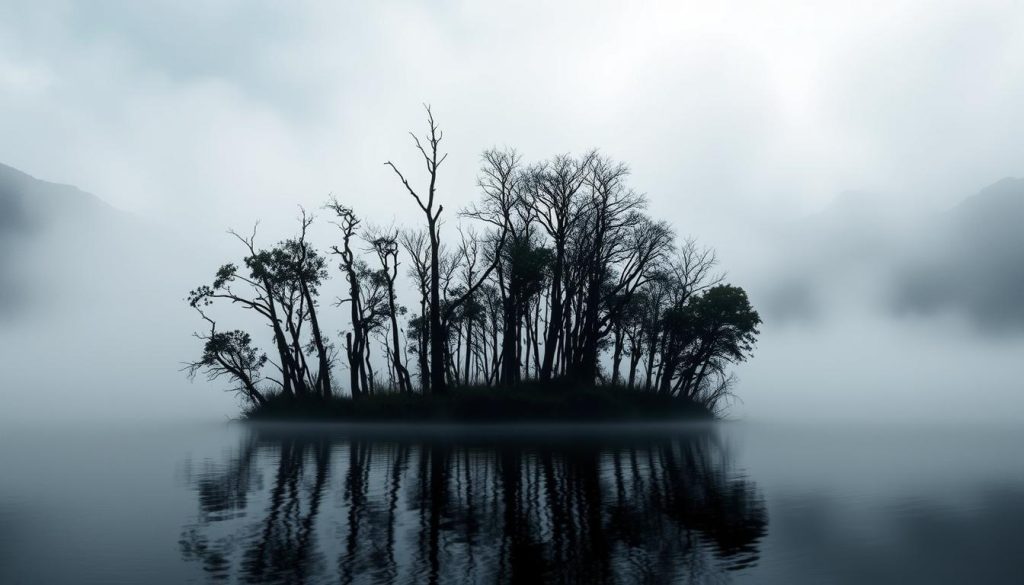
Silent Gas Build-Up in a Volcanic Crater
Lake Nyos sits atop a volcanic crater, where carbon dioxide (CO2) naturally accumulates. Over time, the gas builds up in the deep waters, trapped by the lake’s unique geological conditions. This silent process went unnoticed until the year 1986, when the pressure became too great.
The lake’s volcanic origin played a key role in the disaster. CO2 seeped from the earth’s mantle, dissolving into the water. Without any visible signs, the gas built up to dangerous levels, turning the lake into a ticking time bomb.
The Tragic Night of a Natural Disaster
On August 21, 1986, the unthinkable happened. A massive bubble of CO2 erupted from the lake, releasing a deadly cloud that flowed into nearby villages. The gas, heavier than air, suffocated everything in its path. Nearly 1,750 people lost their lives, along with countless animals and birds.
The disaster struck without warning. Survivors described an eerie silence before the gas cloud descended. The rapid impact left entire communities devastated, with no time to escape. The event remains one of the most tragic natural disasters in modern history.
“Lake Nyos serves as a stark reminder of nature’s hidden dangers and the fragility of life.”
Today, scientists continue to study Lake Nyos to prevent future disasters. The mystery of its deadly eruption has led to innovations in gas monitoring and lake management. While the lake now appears calm, its history serves as a powerful lesson in the unpredictable forces of nature.
Lake Peigneur, Louisiana: When Drilling Unleashed a Sinkhole
Lake Peigneur’s calm waters hid a disaster waiting to happen. In 1980, a routine drilling operation by Texaco turned this peaceful body of water into a swirling vortex. The drill punctured an underwater salt mine, creating a massive sinkhole that swallowed barges, trees, and even parts of the surrounding land.
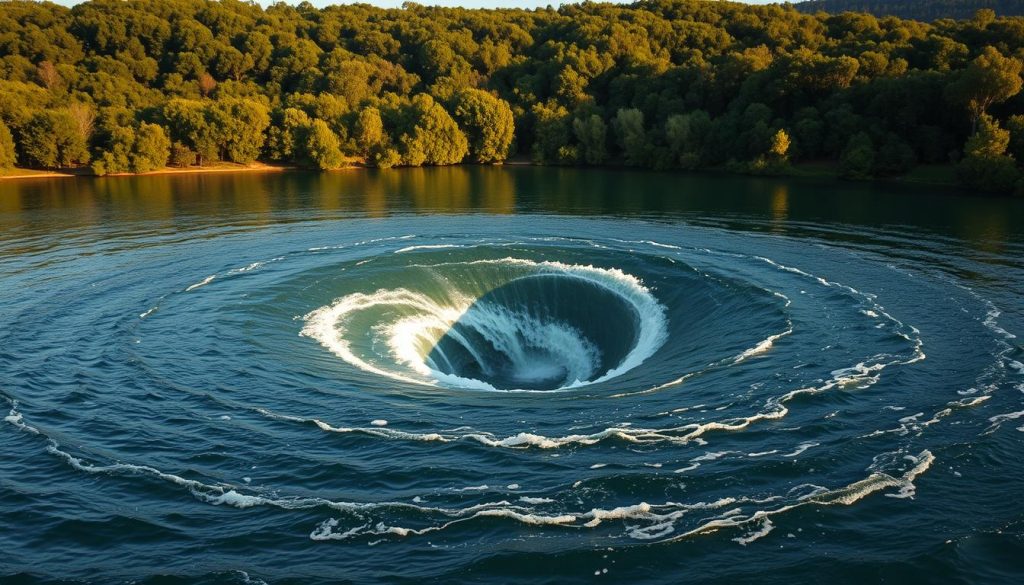
An Industrial Accident Turns into a Vortex
The disaster began when the drill hit the salt mine beneath the lake. Water rushed into the mine, creating a powerful whirlpool. Barges and equipment were sucked into the vortex, disappearing into the depths. The once-placid place became a scene of chaos.
Scientists later explained that the lake’s water drained into the mine, causing the sinkhole. The force of the water carved out a new landscape, leaving behind a stark reminder of nature’s power.
Miraculous Escapes Amid Nature’s Fury
Despite the destruction, no lives were lost. Eyewitnesses described the terrifying moment when the lake seemed to come alive. Workers and nearby residents escaped just in time, leaving behind their equipment and belongings.
The aftermath was eerie. The lake’s water level dropped dramatically, and the surrounding land was reshaped. Today, Lake Peigneur stands as a testament to the unpredictable forces of nature and the resilience of those who witnessed its transformation.
“The lake’s sudden change was both terrifying and awe-inspiring, a reminder of how fragile our world can be.”
- The drilling mishap turned a calm lake into a swirling vortex.
- Barges, trees, and land were engulfed by the sinkhole.
- Scientists explained the phenomenon, linking it to the salt mine collapse.
- Eyewitness accounts highlight the miraculous escapes.
- The eerie aftermath reshaped the landscape forever.
Baotou Toxic Lake, Inner Mongolia: Pollution’s Surreal Landscape
Hidden in Inner Mongolia lies a lake that looks like it belongs in a dystopian movie. Baotou Toxic Lake, a manmade body of water, is a stark reminder of the environmental cost of industrial progress. Its bleak, monochrome appearance and hazardous nature make it one of the most surreal landscapes on Earth.
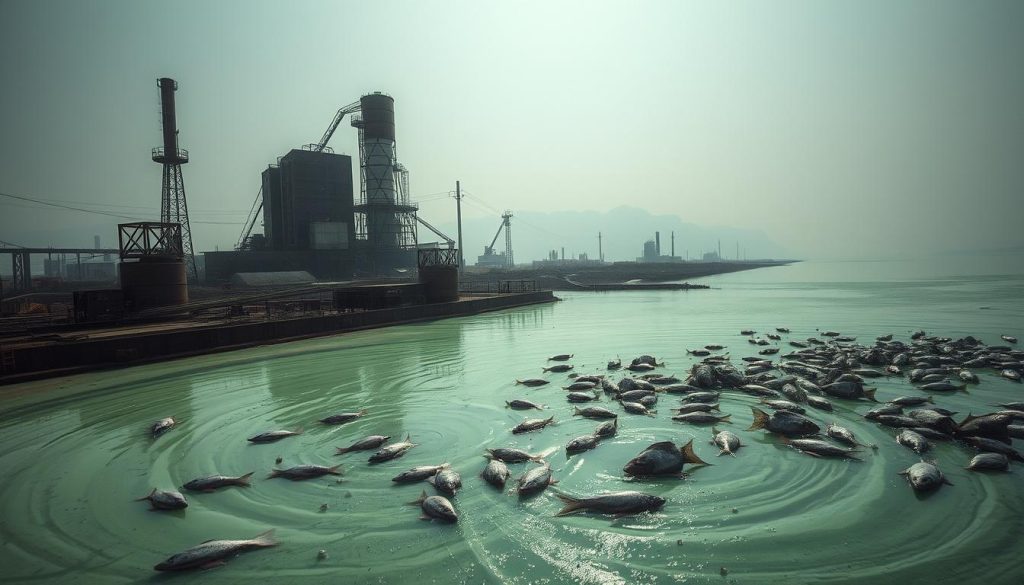
The Manmade Origin and Shocking Appearance
Baotou Toxic Lake was created as a byproduct of unregulated mining and refining operations. Over time, industrial waste from rare earth mineral processing filled the area, forming this toxic reservoir. The lake’s surface is perpetually dark, covered in sludge that gives it an almost alien appearance.
Environmental studies have revealed alarming levels of hazardous materials in the water. The science behind its formation points to decades of neglect and unchecked industrial activity. The lake’s eerie silence, broken only by the occasional sound of wind, adds to its unsettling atmosphere.
Environmental Concerns and Broader Impact
The ecological impact of Baotou Toxic Lake is devastating. The surrounding land is barren, and the water is unfit for any form of life. Scientists warn that the toxic substances could seep into groundwater, posing long-term risks to the community.
Local residents have borne the brunt of this industrial legacy. Health issues and environmental degradation have become part of daily life. The lake serves as a cautionary tale about the consequences of prioritizing profit over sustainability.
| Feature | Impact |
|---|---|
| Manmade Origin | Result of unregulated mining and refining |
| Appearance | Dark, sludge-covered surface |
| Environmental Concerns | Hazardous materials, barren land |
| Community Impact | Health issues, environmental degradation |
Baotou Toxic Lake is more than just a polluted body of water—it’s a symbol of the delicate balance between industrial progress and environmental preservation. Its surreal landscape serves as a haunting reminder of the choices we make and their lasting impact on the planet.
Lake Natron, Tanzania: Nature’s Stone-Casting Waters
Lake Natron in Tanzania is a place where nature’s chemistry takes a chilling turn. This area is known for its extreme alkalinity, with water pH levels reaching up to 12. Such conditions make it one of the most hostile environments on Earth, yet it’s also a site of haunting beauty.
The lake’s waters are rich in natron, a natural compound that has a unique effect on wildlife. Animals that come into contact with the water often become calcified, turning into eerie stone statues. These remains line the shore, creating a ghostly tableau that fascinates and unnerves visitors.
The Chemical Recipe Behind Petrification
The process of petrification begins when an animal dies in or near the lake. The high levels of sodium carbonate and bicarbonate in the water act as a preservative, essentially mummifying the body. Over time, the remains harden, taking on the appearance of stone sculptures.
This phenomenon is not just a macabre curiosity—it’s a scientific marvel. Researchers have studied the lake to understand how its unique chemical composition interacts with organic matter. The results share insights into natural preservation processes that are rarely seen elsewhere.
Along the lake’s edge, visitors can find petrified birds and other animals, frozen in time. These remains serve as a stark reminder of the lake’s deadly beauty. The area is also home to flamingos, which thrive in the harsh conditions, adding a touch of life to the otherwise desolate landscape.
“Lake Natron is a testament to nature’s ability to create both beauty and danger in equal measure.”
The intersection of science and the macabre makes Lake Natron a must-see for those fascinated by the mysteries of the natural world. Its eerie area and unique phenomena share a story that is as captivating as it is unsettling.
Kawah Ijen Crater Lake, Indonesia: Fiery Beauty with a Lethal Edge
Deep within Indonesia’s volcanic landscape lies a lake that defies imagination. Kawah Ijen Crater Lake is a place where fire and water coexist in a mesmerizing yet deadly way. Its neon blue flames and acidic waters create a spectacle that is both beautiful and hazardous.
Neon Blue Flames and Lethal Acidic Waters
At night, Kawah Ijen transforms into a surreal scene. Neon blue flames dance across its surface, caused by burning sulfur gases escaping from the volcano. This phenomenon, known as “blue fire,” is rare and occurs in only a few places on Earth.
Below the flames lies a lake with a pH level of 0, making it one of the most acidic bodies of water in the world. The water’s toxicity is a result of the volcano’s constant activity, which releases sulfuric gases into the lake. This lethal combination makes the lake both fascinating and dangerous.
The Paradox of Labor and Natural Hazard
Despite the hazards, local miners brave the toxic environment to extract sulfur. For decades, they have carried heavy loads of sulfur up the steep crater walls, often without protective gear. Their work is essential for industries like cosmetics and fertilizers, but it comes at a great personal cost.
The miners’ resilience highlights the duality of Kawah Ijen. It is a place of natural wonder and a source of livelihood, yet it poses significant risks. This paradox makes the lake a symbol of both beauty and hardship.
| Feature | Description |
|---|---|
| Neon Blue Flames | Caused by burning sulfur gases |
| Acidic Waters | pH level of 0, highly toxic |
| Miners’ Work | Extracting sulfur under hazardous conditions |
| Geological Activity | Constant volcanic activity sustains the phenomenon |
Kawah Ijen Crater Lake is a testament to the raw power of nature. Its fiery beauty and lethal edge remind us of the delicate balance between awe and danger. For those who visit, it offers a glimpse into a world where the extraordinary and the perilous coexist in a unique way.
10 Strange Lakes That Defy Scientific Explanation: Pitch Lake, Lost Lake, and Yellowstone Lake
Across the globe, certain bodies of water defy logic and spark curiosity. From asphalt deposits to vanishing waters and hidden volcanic threats, these lakes are as mysterious as they are fascinating. Each has a unique story, blending science and wonder in ways that leave us in awe.
Pitch Lake, Trinidad: A Vast Reservoir of Liquid Asphalt
Pitch Lake in Trinidad is a natural wonder unlike any other. This massive reservoir is filled with liquid asphalt, a sticky, tar-like substance that has fascinated scientists for centuries. The lake’s surface varies from solid to quicksand-like, creating a treacherous yet intriguing layer that shifts over time.
Formed by the seepage of oil from deep beneath the earth’s crust, Pitch Lake has been a source of asphalt for centuries. Its unique composition makes it a valuable resource, but it’s also a reminder of nature’s ability to create the unexpected. Visitors can walk on its surface, though caution is advised—it’s easy to sink into its sticky depths.
Lost Lake, Oregon: The Enigma of Disappearing Waters
Lost Lake in Oregon is famous for its seasonal vanishing act. Every summer, the lake’s waters drain away, leaving behind a dry basin. The mystery lies in its underground lava tubes, which act as natural drains, pulling the water to the side and out of sight.
This phenomenon has puzzled locals and scientists alike. The lake’s disappearance is a reminder of the hidden forces shaping our world. In winter, the water returns, filling the basin once more and creating a cycle that continues to captivate those who witness it.
Yellowstone Lake, USA: The Silent Threat of a Supervolcano
Yellowstone Lake may appear serene, but beneath its surface lies a silent threat. The lake sits atop a supervolcano, and signs of its activity are evident. A growing dome at the bottom of the lake hints at the immense pressure building below.
Scientists monitor the area closely, as the supervolcano’s eruption could have catastrophic consequences. The lake’s beauty masks the danger, creating a paradox that reminds us of nature’s dual nature. It’s a place where tranquility and peril coexist, offering a glimpse into the earth’s powerful forces.
“These lakes remind us that nature’s mysteries are as vast as they are varied, challenging our understanding and sparking endless curiosity.”
Conclusion
From sudden appearances to deadly secrets, these bodies of water continue to captivate and confuse. Each one challenges our understanding of nature, blending science with local legends. Whether it’s a lake that appears overnight or one that turns animals to stone, these phenomena remind us of the power and unpredictability of the natural world.
These mysteries also highlight the human desire to explore and explain the unknown. They raise important questions that push scientists to dig deeper. Continued research can help us better understand these phenomena and their impact on the environment.
As we marvel at these wonders, it’s essential to respect their power. Nature’s secrets are vast, and our curiosity drives us to uncover them. What other mysteries might these bodies of water hold? Share your thoughts and questions—let’s keep the conversation flowing.
FAQ
What makes a lake appear mysterious or strange?
A lake can seem mysterious due to unusual colors, sudden appearances, or unexplained phenomena like petrification or toxic gases. These features often blend science with local stories, creating a sense of wonder.
How did Gafsa Lake in Tunisia form so suddenly?
Gafsa Lake appeared unexpectedly in 2014, likely due to underground water shifts caused by unregulated mining. Its bright blue waters drew attention, but its origins remain partly unexplained.
What is the story behind Roopkund Lake’s frozen remains?
Roopkund Lake, in India, is known for its skeletal remains. Scientists believe these belong to travelers who died centuries ago, possibly due to a sudden hailstorm, as local legends suggest.
What caused the deadly event at Lake Nyos in Cameroon?
In 1986, Lake Nyos released a massive cloud of carbon dioxide from its volcanic crater. The silent gas suffocated nearby villages, marking one of nature’s deadliest disasters.
How did Lake Peigneur in Louisiana transform into a sinkhole?
An industrial drilling accident in 1980 caused Lake Peigneur to drain into a salt mine below. The resulting vortex swallowed equipment and altered the landscape dramatically.
Why is Baotou Lake in Inner Mongolia considered toxic?
Baotou Lake is a manmade reservoir filled with waste from rare earth mining. Its shocking colors and pollution levels highlight the environmental cost of industrial activities.
What makes Lake Natron in Tanzania turn animals into stone?
Lake Natron’s high alkalinity and mineral content can calcify animals that come into contact with its waters, creating eerie, stone-like remains.
What are the dangers of Kawah Ijen Crater Lake in Indonesia?
Kawah Ijen’s lake is highly acidic, and its neon blue flames from burning sulfur make it both beautiful and deadly. Workers face health risks while mining in this hazardous environment.
What is unique about Pitch Lake in Trinidad?
Pitch Lake is a natural asphalt lake, filled with thick, sticky tar. It’s one of the largest deposits of its kind and has been used for centuries for road construction.
Why does Lost Lake in Oregon disappear annually?
Lost Lake drains every year through a volcanic lava tube. This natural phenomenon leaves the lakebed dry, only to refill during the rainy season.
What makes Yellowstone Lake in the USA a potential threat?
Yellowstone Lake lies above a supervolcano. Scientists monitor it closely for signs of volcanic activity, as an eruption could have catastrophic global effects.
